The cold winds coming from the Caspian Sea made me shiver. But I persisted. I wasn’t going to let my early morning walk through Baku’s Icherisheher (Old City) be ruined by winds, I told myself, drawing the jacket closer.
But it was futile. Darkness and silence clung to the old stone buildings and the labyrinthine alleyways were deserted. Somewhere beyond the Old City, Baku’s iconic Flame Towers continued its colourful display of lights – but whoever said that pre-sunrise was the perfect time to witness the glories of Baku had a great sense of humour. It was simply too cold to see or feel anything.
Baku, Azerbaijan’s capital city is called the City of Winds and at this precise moment when debating between returning to my hotel or plodding on, a gust of cold wind blows in. Quick decisions are made. Baku has many stories to tell, but they can wait.
The city’s location on the southern tip of Absheron Peninsula makes it susceptible to constant, bone-chilling winds. However, in the summer months, these winds literally become the breath of fresh air! In Persian language, Baku translates into pounding winds.
Icherisheher – Baku’s cultural heart
I return to Icherisheher when the sun is firmly in the sky. The main entry gate is marked with the city’s shield – the head of Ox protected by lion heads, sun and moon symbolizing 24-hour protection – at once falling in love with the cobbled streets and tightly packed stone houses, many of which continue to house residents. The Fortress Wall has twenty-five towers and five gates – so wishing myself good luck navigating through it all, I march forward.
I soon begin to see why Icherisheher is deemed to be the cultural heart of an otherwise modern Baku.
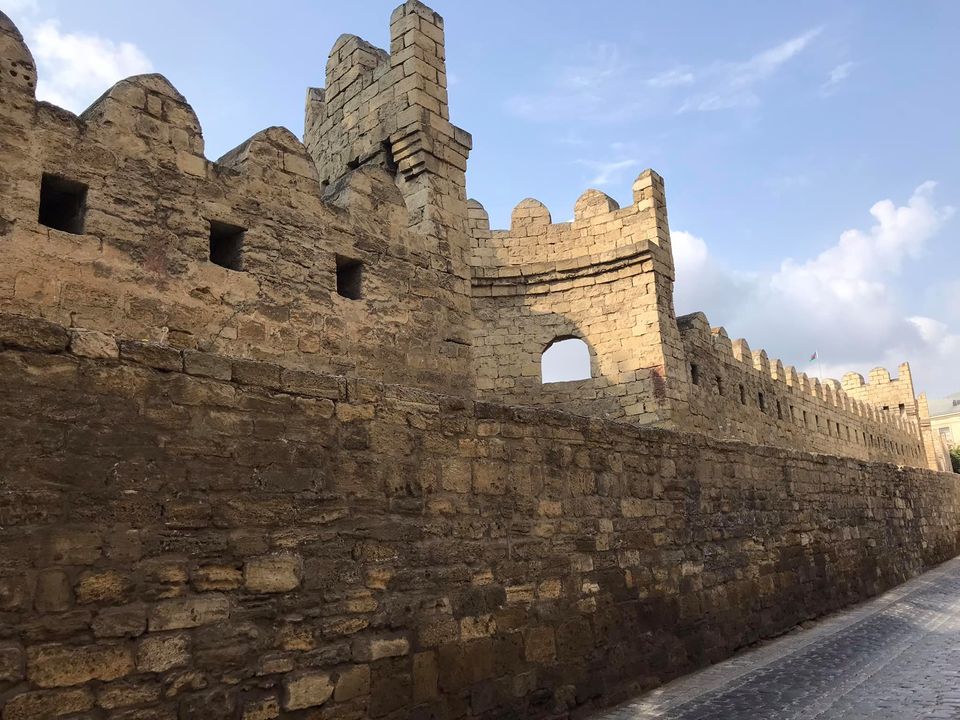
It is as pretty as claimed, despite the several renovations following wars and natural calamities over the centuries. Between the 12th and 15th century, it housed pretty much everyone in Baku. The Fortress Walls protected the city from battles until the 16th century. First constructed in the 12th century, the walls were destroyed several times. In the 16th century, the walls were upgraded and a second, lower fortress wall was added and between the two, a water-filled moat was made.
I walk past restaurants and cafes, relishing the smells from the kitchens. Arthouses are slow to open, it is still chilly – but a cup of tea takes care of that. Served in traditional Armudu glasses, the tea is strong and bracing. Soon I arrive at the door of a museum housing the world’s tiniest books. It is closed.
“Tomorrow,” I tell myself. “I will be back again,” before entering the 15th century Palace of Shirvanshah to explore its burial vaults and mosque but not before snapping the Instagram-worthy picture of Old Shah’s Mosque and super-modern Flaming towers in one frame. The contrast is stark. But it explains the country’s progress in one frame.
I stumble through the Old City, deliberately seeking narrow lanes to avoid the crowds and wind and for a chance to peer through windows into homes for a glimpse of life within.
Finally, I arrive at the Maiden Tower, a UNESCO World Heritage Site and the city’s pride. It is familiar because I’ve seen it on the Azeri currency too. The Zoroastrians are accredited with having built this mysterious tower – ‘mysterious’ because of the many myths and legends surrounding it. The most popular being that of a princess with flaming red hair who thwarted the invading army and charmed the tyrant king into protecting her people holed up in the tower!
From the outside, this 30m tall stone tower looks untouched, however, to reach the top, a staircase has been added and every landing is equipped with a museum Baku’s history.
The view from the roof is mesmerizing. The 360-degree view includes alleys and minarets of the Old City, Baku Boulevard, the wide vista of Baku Bay, De Gaulle House and of course the Flaming Towers.
I retire to a caravanserai for tea. No trace of the Silk Route days can be seen, but imagination fills the gaps. The cobbled streets are bursting with antique-sellers and I give in to my temptation and secure a cobalt-blue bowl claimed to come from ‘Soviet Union.’
And not for a moment till I leave, have the winds abated. However, the brutal winds of Baku are a crucial part of the city’s identity and have contributed to the nation’s history.
Yanar Dag – a mountain that burns
The next morning, I head out of the city to see why Azerbaijan was called the Land of Fire. I am told that the exceptional mix of wind and fire is what made Azerbaijan one of the world’s oldest and most advanced civilizations.
The fires are burning relentlessly across a 10m stretch when I arrive at the Burning Mountain or Yanar Dag. This fire has been burning for 4,000 years through sun, wind, rain and snow. Fascinating as it is to watch the dance of the flames, the depletion of natural gas, I am told, doesn’t guarantee many years for this natural occurrence.
Once upon a time, the fire covered the entire mountain but Soviet exploitation in the 20th century caused most natural fires to die.
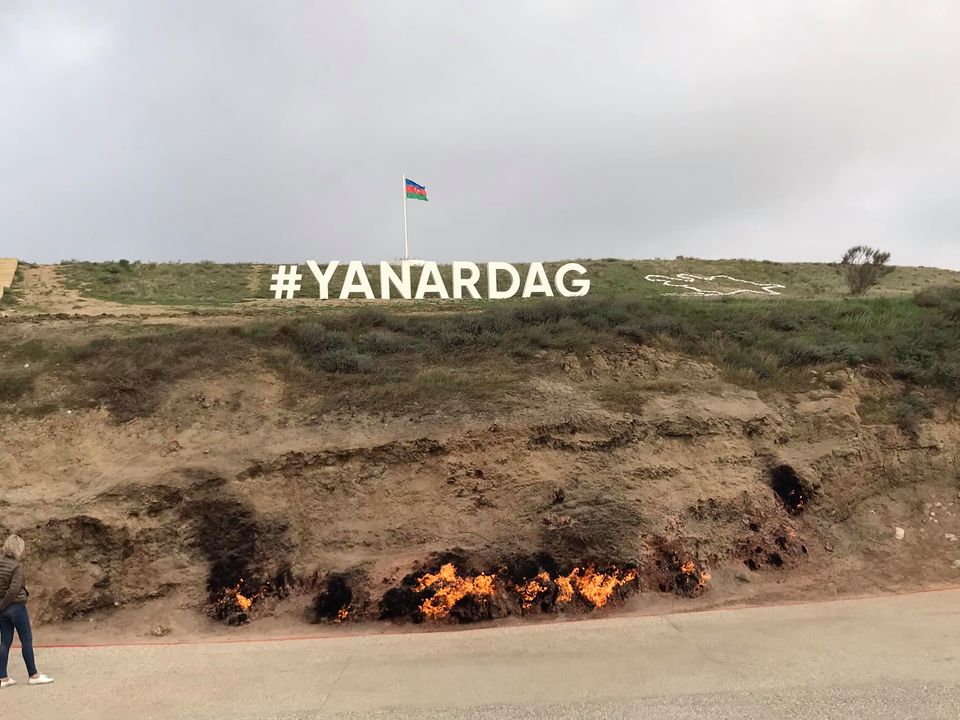
Azerbaijan’s unique physical geology that includes rugged limestone mountain ridges, peaking crests, towering rocks and vast, almost barren 1000m tall plateaus hides vast reserves of oil and natural gas. High pressure pushes the gas out through fissures, which ignites when in contact with air. The flames continue to burn as long as the fuel flows – which explains the burning mountains and temple fires (of Ateshgah), my next destination.
The Fire Temple of Baku
The Fire Temple (Ateshgah) is playing host to curious visitors when I arrive. A wide courtyard leads me to the cupola-topped central altar, where a tall fire is burning steadily, its flames dancing in the ever-present wind. However, the current fire is gas-fueled (the natural fire died down few years ago) but that hasn’t diminished its importance.
Recently renovated, Ateshgah Temple (Persian for Home of Fire) built around 200 A.D, was one of the most important Zoroastrian temples and served as an important point for traders, merchants and pilgrims travelling the Silk Road from China and India. For the Zoroastrians, fire was an important element as it represented ‘light of wisdom.’ Due to the naturally occurring fire at Ateshgah, early inhabitants settled in the area, both as a convenience and manifestation of beliefs.
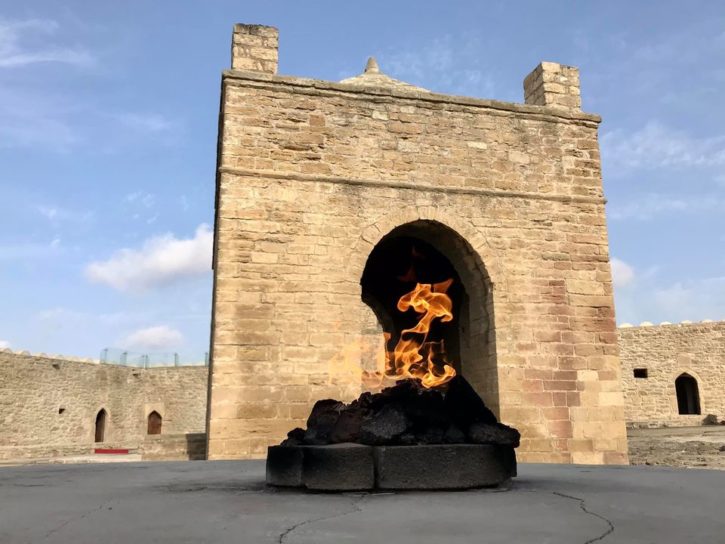
The pentagonal complex is believed to have been built in the 17th and 18th century by Indian settlers in Baku, although the fire rituals here date back to the 10th century or earlier. The temple is associated with Zoroastrianism, but its history as a Hindu place of worship is documented. The central altar is surrounded by small ‘cells’ in which are representations of life of yore and small places of worship. Many travelers (particularly Jains and Sikhs) eventually settled at Ateshgah, bringing with them their own brand of fire worship and setting the stage for Azerbaijan’s extraordinary multiethnic identity and unparalleled religious tolerance.
In some ways, I understand how the combination of wind and fire led to the nation’s advancement.
I return to Baku – the city of winds thriving in the land of fire to wind down for the day.
Mud Volcanoes of Gobustan
For the real joy of seeing the mud volcanoes, I was looking forward to Day 3 of my trip. I’d heard much about the volcanoes and of course the cave art of Gobustan, so I knew it was going to be a day filled with information and fun. The one-hour journey to the site was fascinating because I’d never have imagined that the dry, sandy desert like landscape could hide anything at all like the famed Gobustan Rock Art collection. My driver drove me to the now arid and abandoned collection of caverns and rocks which includes more than 6,000 engravings and paintings dating from between 20,000 and 3,000 B.C.
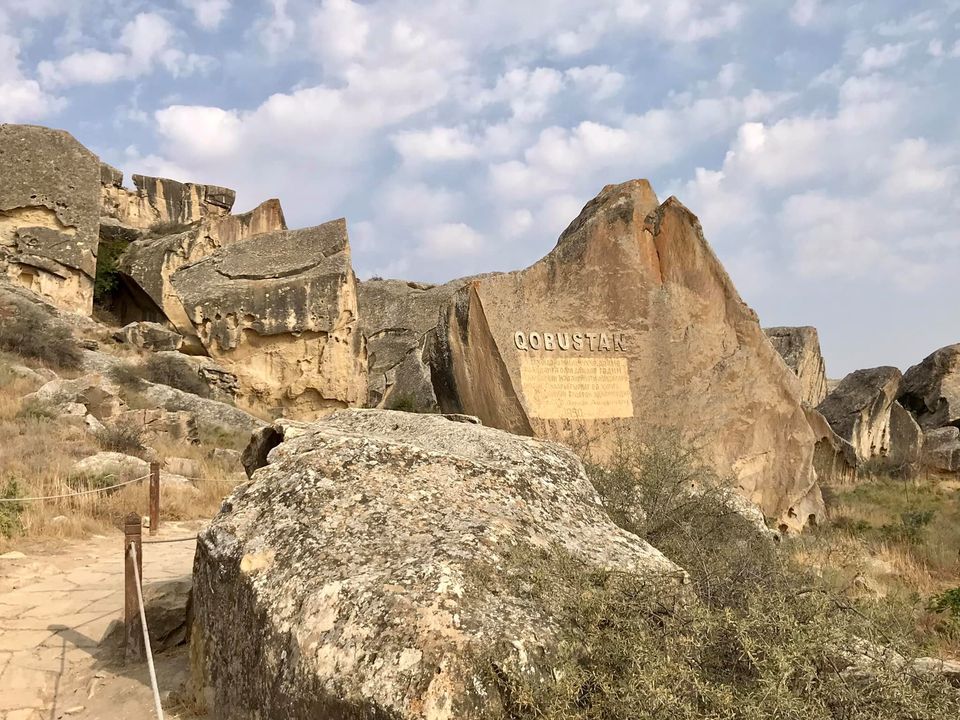
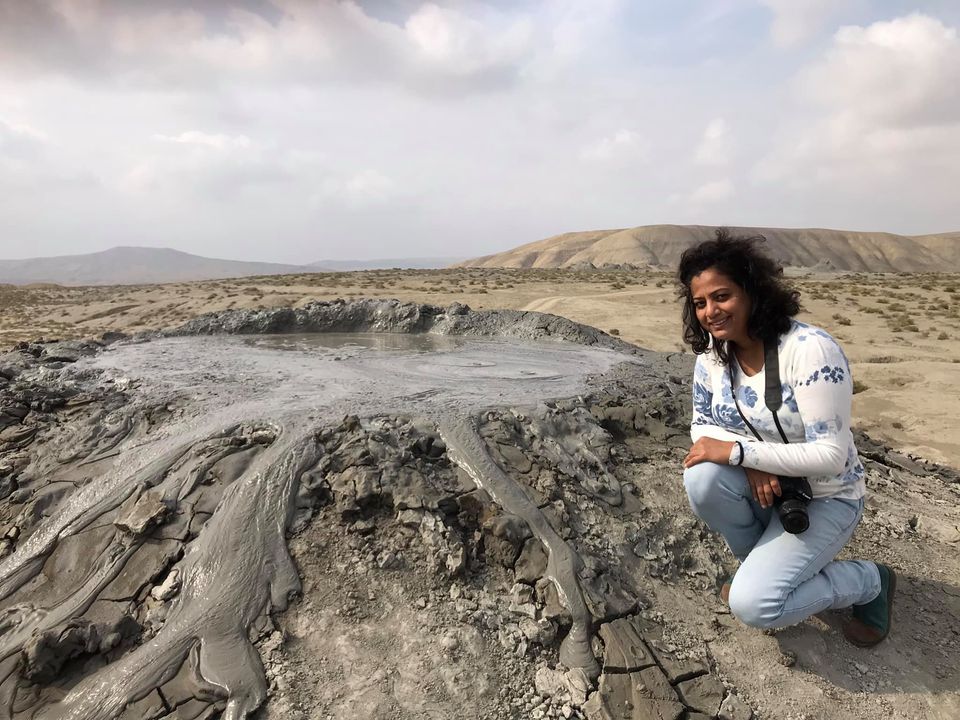
A walk through the site feels surreal. It is was like walking through a time set thousands of years ago – past huge overhanging carved rocks – which eventually gave Gobustan the status of a UNESCO World Heritage site (2007), one among the four protected sites in the country. Although the Gobustan petroglyphs are not as old as those found in the Franco-Cantabrian region of western Europe (dating from about 35,000 years ago), they are far more sophisticated and complex.
In some of Gobustan’s cave paintings, men could be seen dancing and hunting, while women were shown gathering plants and caring for their young. Some of the women are even depicted as pregnant, perhaps as symbols of fertility.
We leave the rock-site towards the highlight of the day. Mud volcanoes.
I’d read about this naturally occurring phenomenon. It is said that these volcanoes have been around for over 4000 years. It is proven that of the 700 mud volcanoes in the world, Azerbaijan alone has about 350 of them. We cross some flatlands dotted with carcass of sheep to arrive at the (sadly neglected) site of this beauty. On a small patch of a hill were small volcanoes -their past evidenced in the caked run offs on its sides. Seeing my disappointment, the driver pointed to a relatively larger one, few meters away.
And true enough, there it was, one active volcano, bigger and higher than the rest, actively spewing cold mud and bubbles into the air. The place of eggs – or so I thought as I scramble up the cone-like ‘volcano’ to reach the top in a few short steps – and sure enough, right before my eyes, it bubbled and popped. As I watched, a large bubble formed, grew bigger and burst into a cold grey mud spray. I leaned in as far as I could for a closer look without risking a fall into the cold slate-grey slurry. Truth be told, mud volcanoes aren’t the same as igneous volcanoes because they are powered by water and gas – and Azerbaijan is filled with both. In fact, the presence of these indicates the abundance of oil and gas resources.
Azerbaijan had indeed rewarded me in peculiar ways.
Did you know…
|

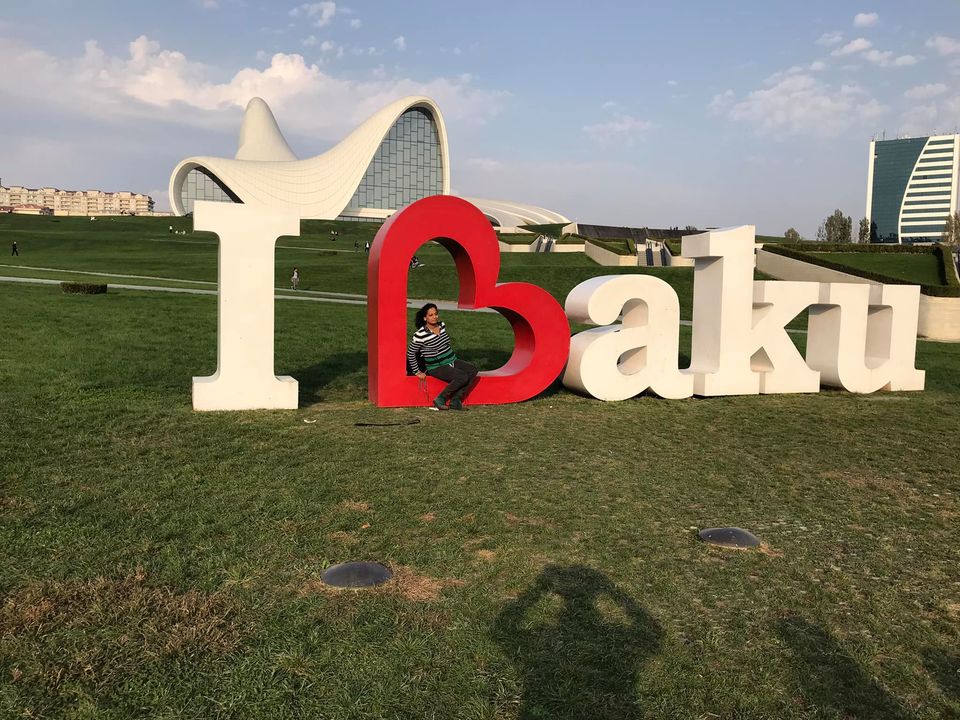
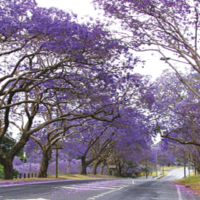

Enjoying your post.